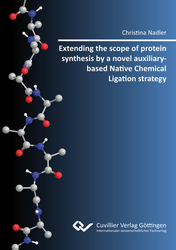| Departments | |
|---|---|
| Book Series (96) |
1378
|
| Nachhaltigkeit |
3
|
| Gesundheitswesen |
1
|
| Humanities |
2364
|
| Natural Sciences |
5406
|
| Mathematics | 229 |
| Informatics | 319 |
| Physics | 980 |
| Chemistry | 1363 |
| Geosciences | 131 |
| Human medicine | 243 |
| Stomatology | 10 |
| Veterinary medicine | 108 |
| Pharmacy | 147 |
| Biology | 835 |
| Biochemistry, molecular biology, gene technology | 121 |
| Biophysics | 25 |
| Domestic and nutritional science | 45 |
| Agricultural science | 1004 |
| Forest science | 201 |
| Horticultural science | 20 |
| Environmental research, ecology and landscape conservation | 148 |
| Engineering |
1793
|
| Common |
98
|
|
Leitlinien Unfallchirurgie
5. Auflage bestellen |
|
Advanced Search
Extending the scope of protein synthesis by a novel auxiliary‐based Native Chemical Ligation strategy (English shop)
Christina Nadler (Author)Preview
Extract, PDF (480 KB)
Table of Contents, PDF (56 KB)
There is a constant need for developing improved methods for introducing artificial functionalities into peptides and proteins, as the modification of peptides and proteins is one of the major routes to investigate biological function in vitro and in vivo, e.g. by introduction of spin labels or fluorophores. To improve the synthetic accessibility of chemically modified peptides and proteins a new cysteine-free Native Chemical Ligation strategy based on a photocleavable auxiliary was developed and successfully implemented. In addition, a novel protocol for labeling peptides and proteins by introducing artificial, histidine-mimicking amino acids was devised. These triazole-based building blocks were utilized for the introduction of additional metal binding sites into peptides as well as for the development of peptidic zinc sensors based on zinc finger peptide Zif268.
| ISBN-13 (Hard Copy) | 9783954045044 |
| ISBN-13 (eBook) | 9783736945043 |
| Final Book Format | A5 |
| Language | English |
| Page Number | 198 |
| Lamination of Cover | matt |
| Edition | 1. Aufl. |
| Publication Place | Göttingen |
| Place of Dissertation | Göttingen |
| Publication Date | 2013-09-18 |
| General Categorization | Dissertation |
| Departments |
Chemistry
Organic chemistry |
| Keywords | Organische Chemie, Peptidchemie, Festphasensynthese, SPPS, Native Chemical Ligation, cystein-freie Native Chemical Ligation, Ligationsauxiliar, Photolabilität, artifizielle Aminosäuren, Histidinmimetika, Single Amino Acid Chelate, Kupfer-katalysierte Azid-Alkin-Cycloaddition, Fluoreszenzspektroskopie, Zinksensoren, Zinkfingerpeptide, Zif268, Substratanalogon, Lipoxygenase. |








